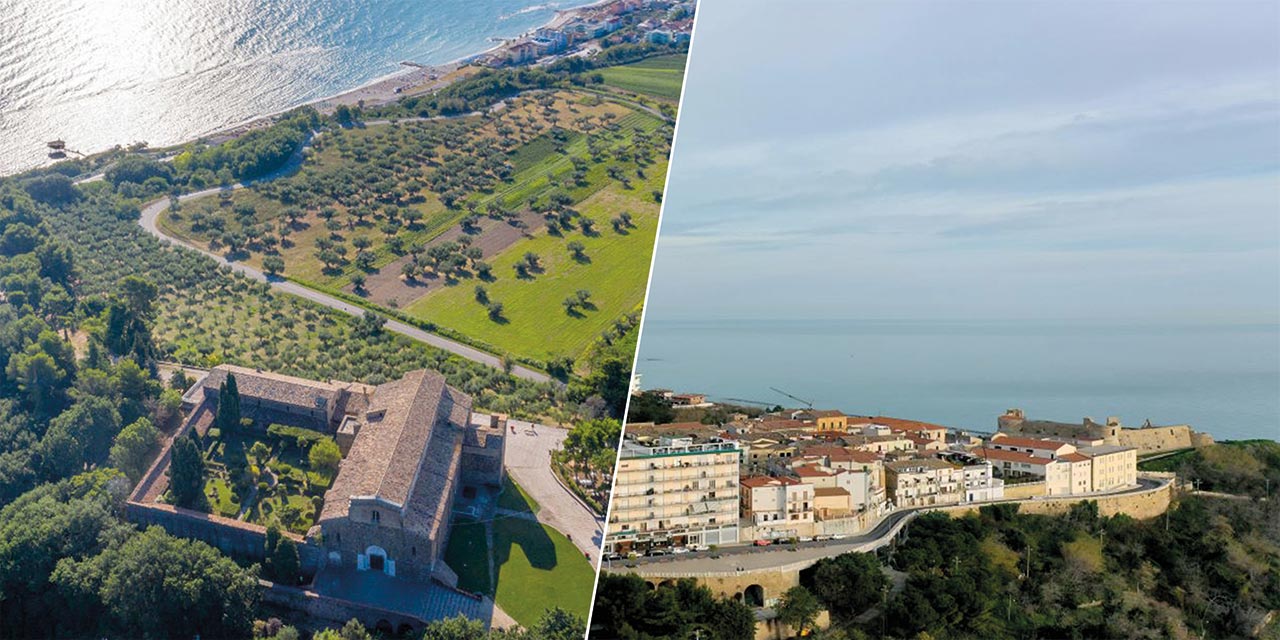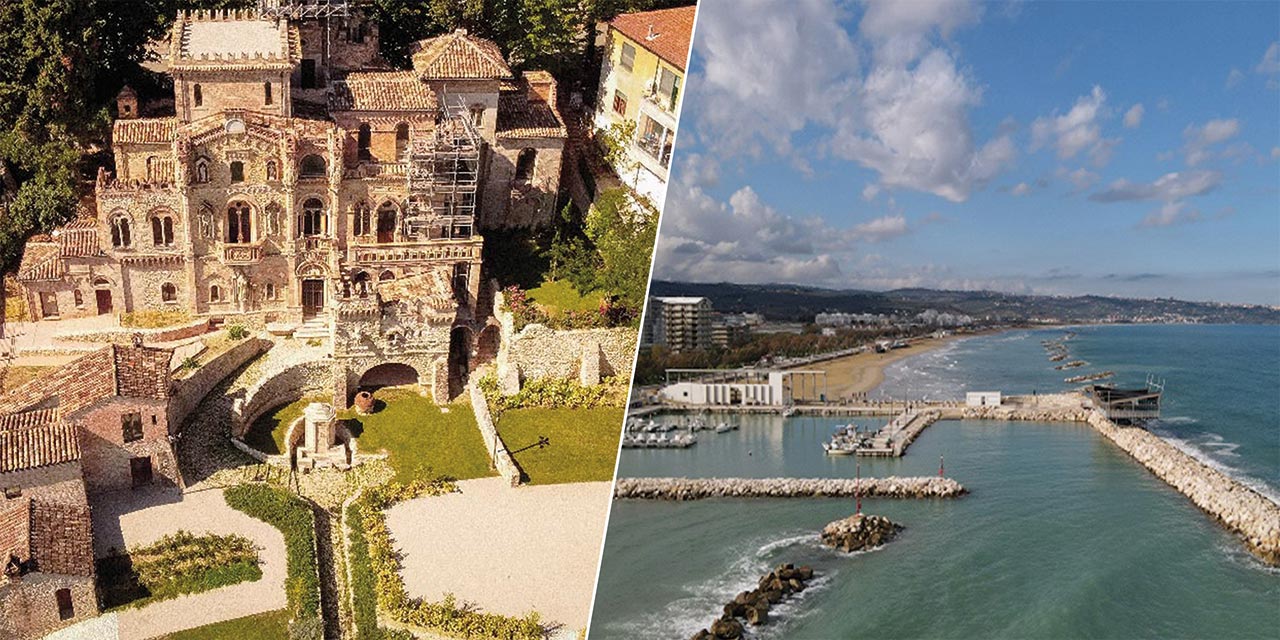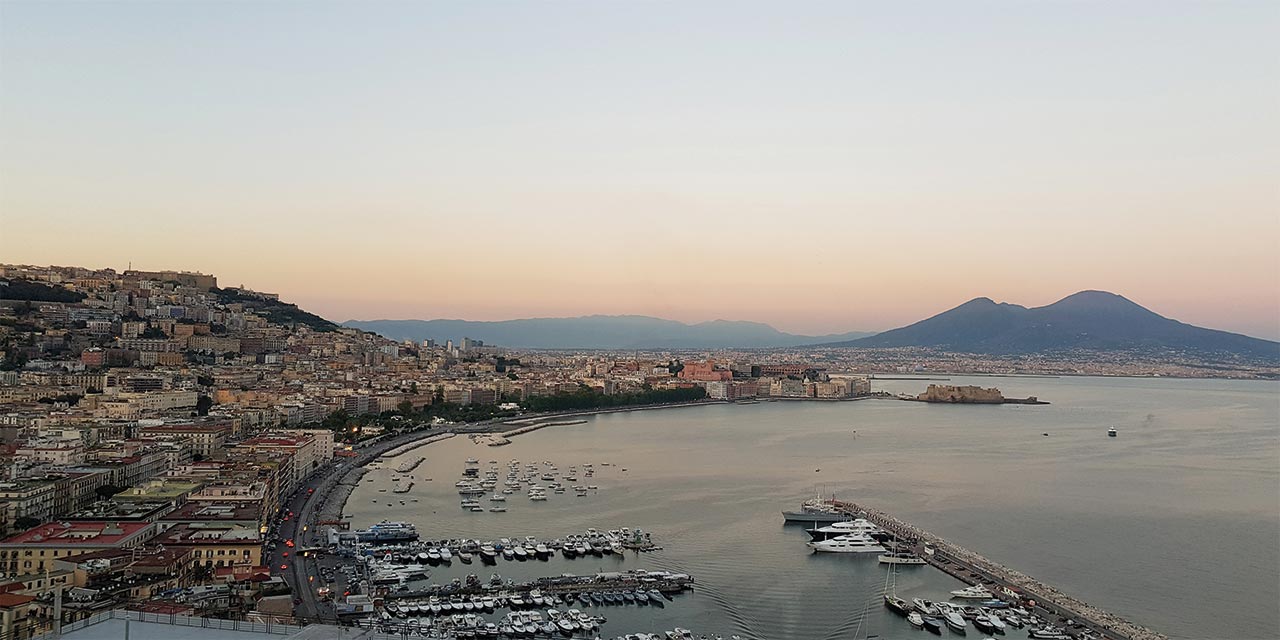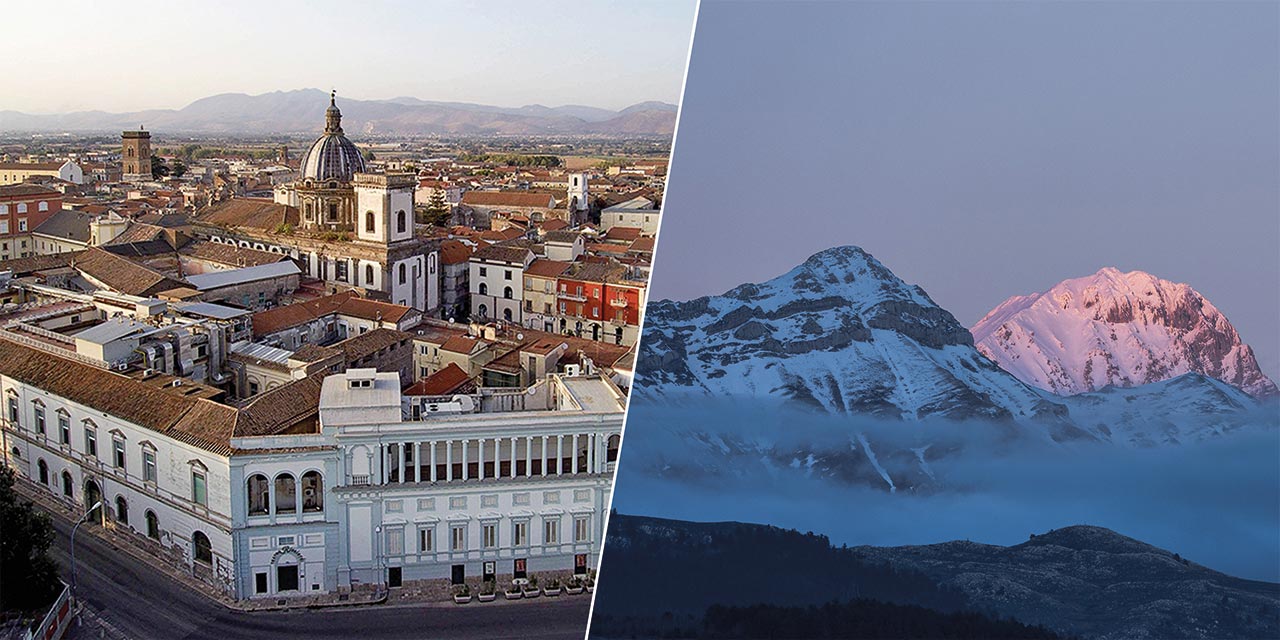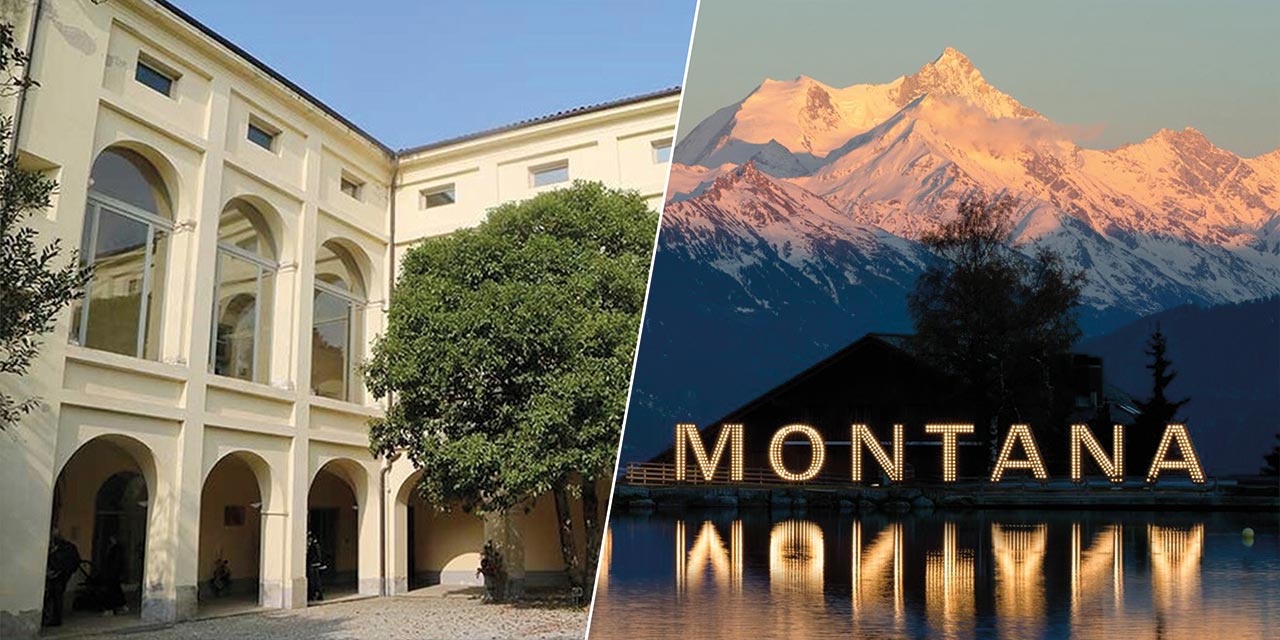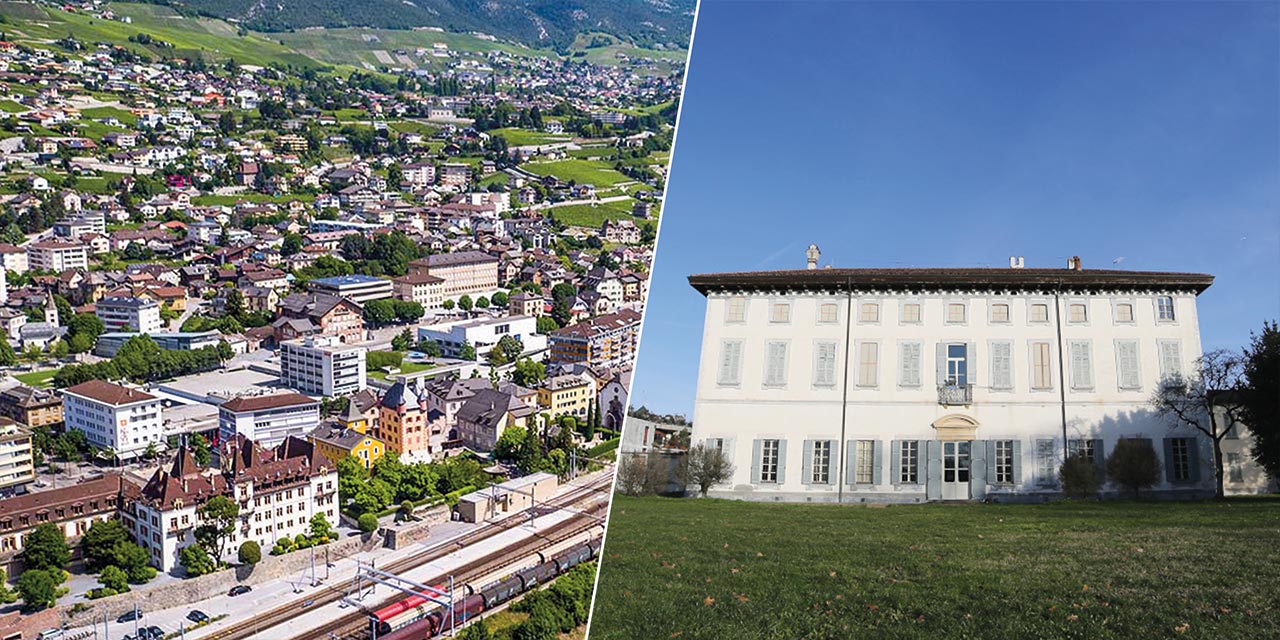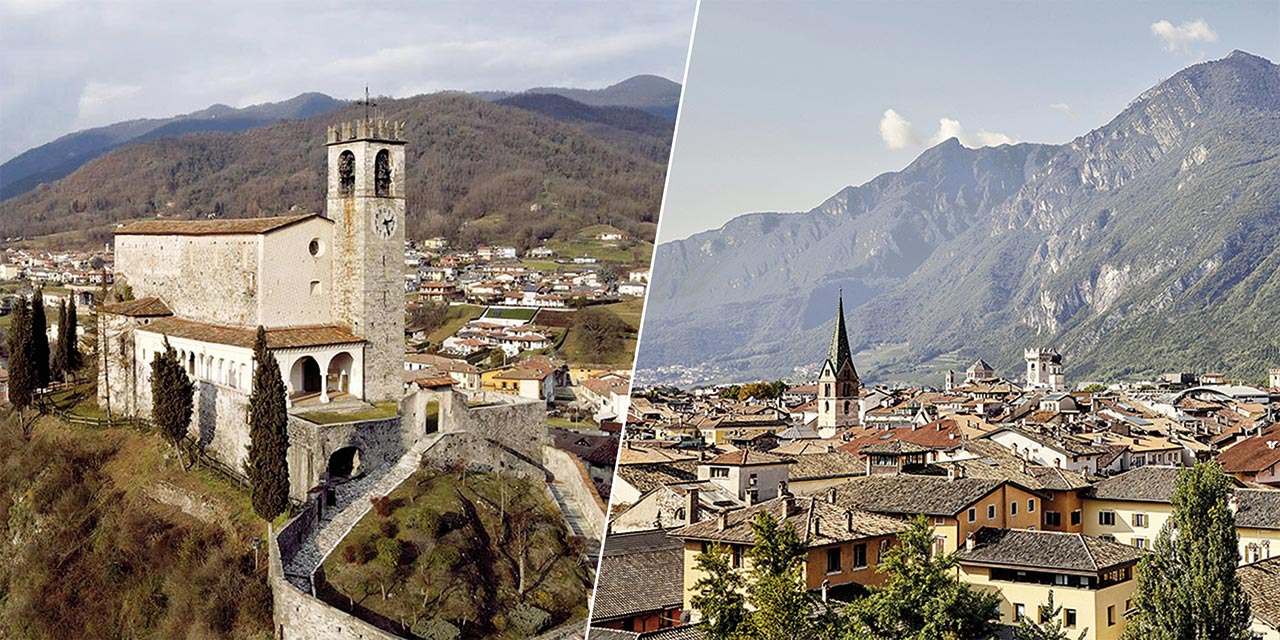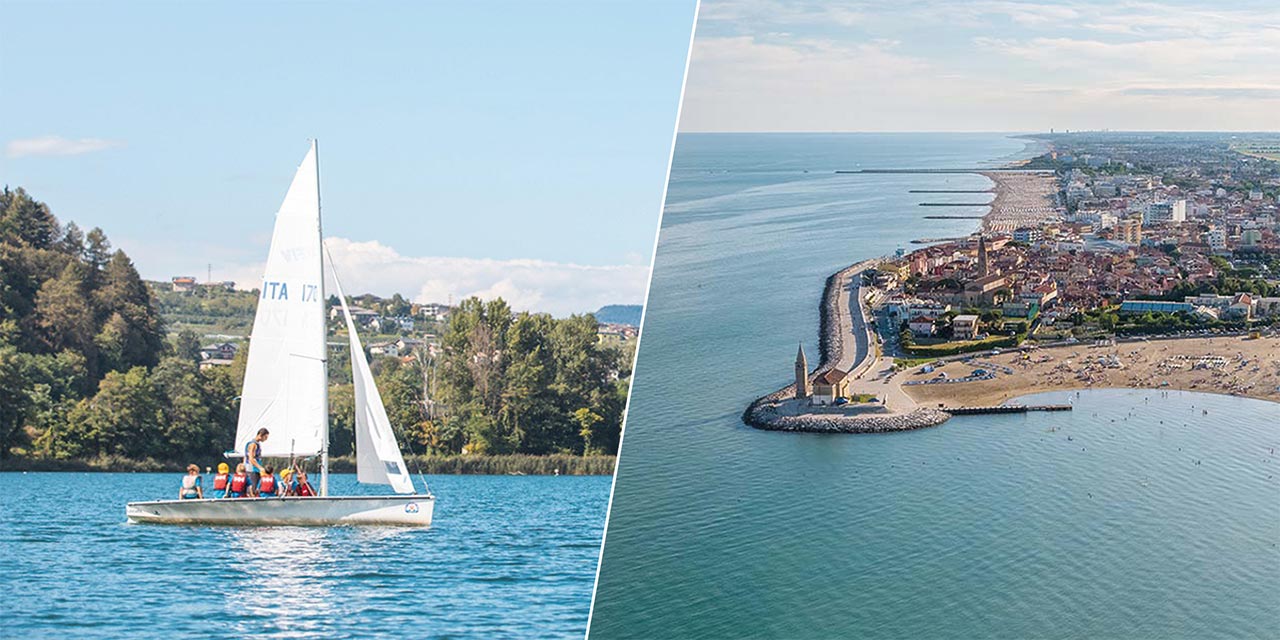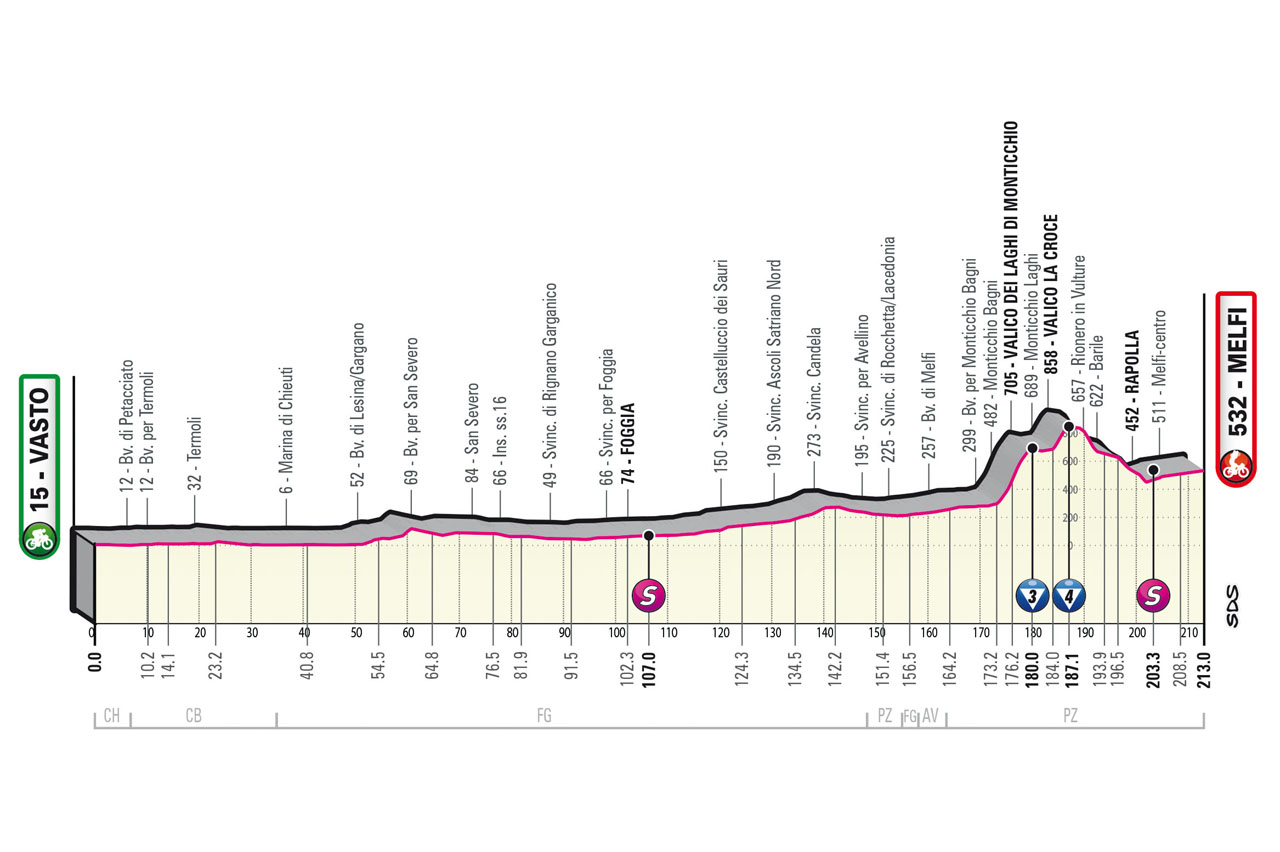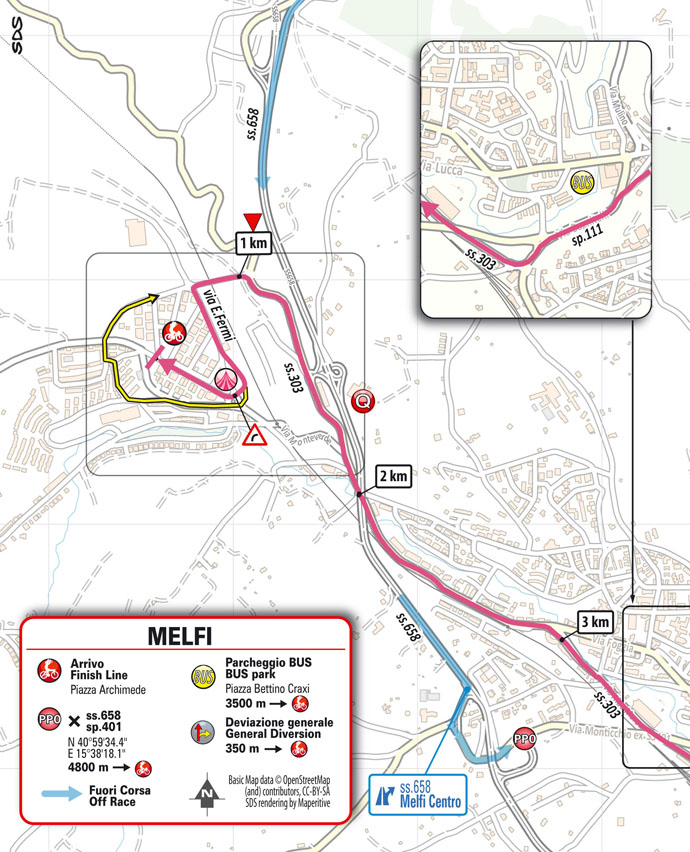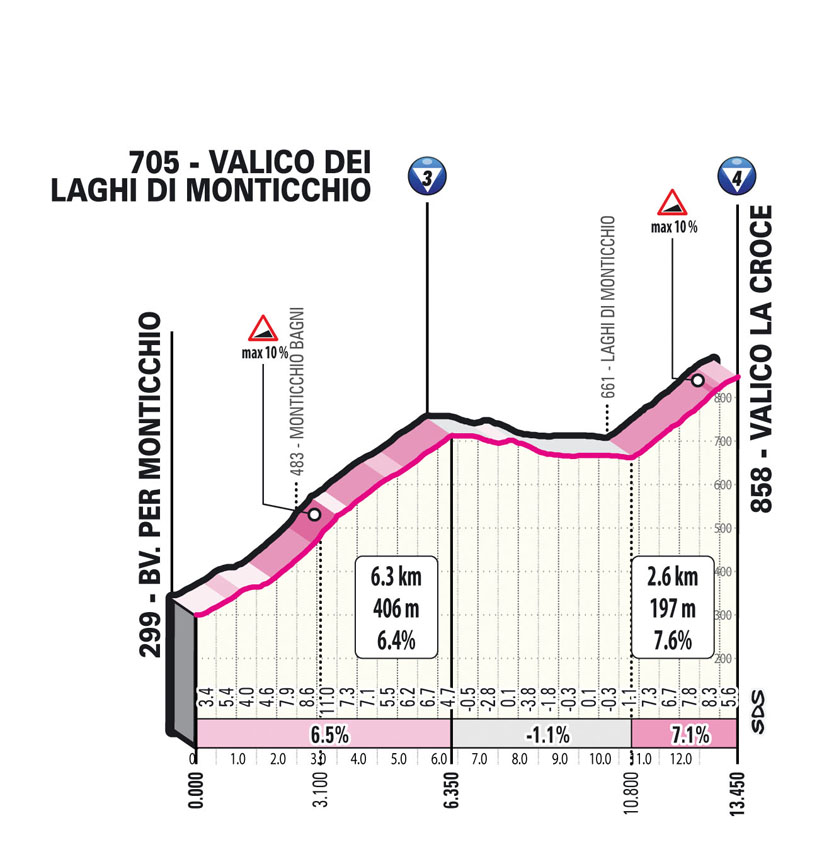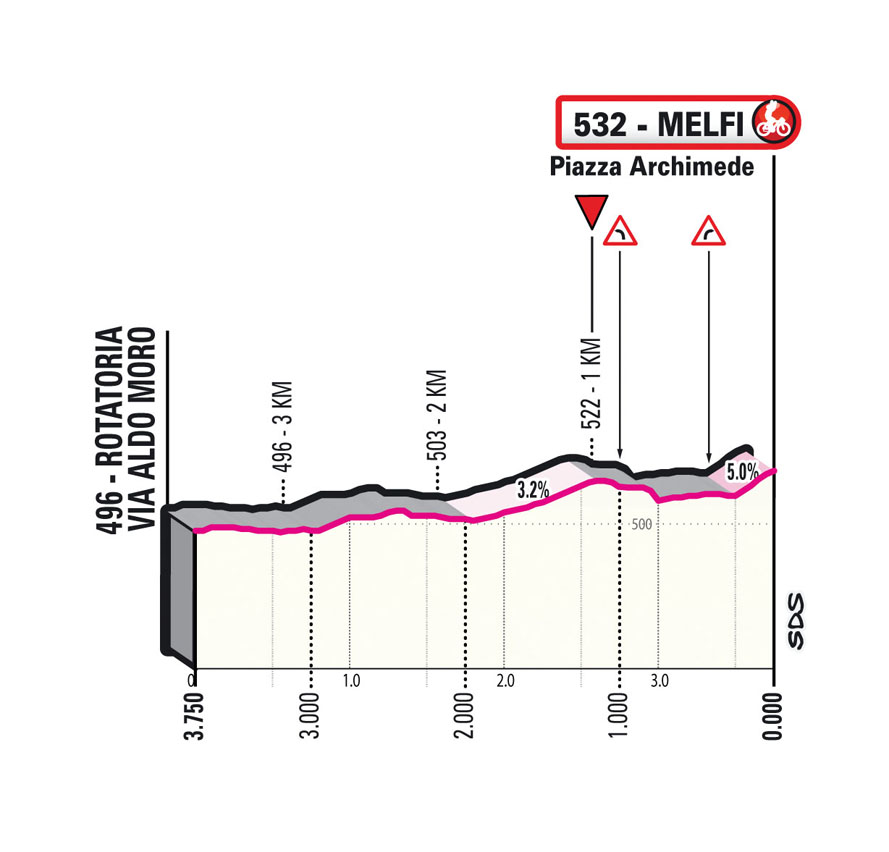profile
map
technical info
The route
This stage is divided into two distinct parts. It begins flat for 170 km, on wide and mostly fast‑flow roads, with a few mild bends. The route then changes as it reaches the Monti del Vulture. The road that leads through the Valico dei Laghi di Monticchio to the lakes is intricate, rising with 6‑7% gradients. After a short descent, the route climbs up the Valico la Croce, reaches Rionero in Vulture and then continues, winding its way mostly downhill, on relatively wide roads, all the way to Melfi.
Final kilometres
After a short climb to the centre of Melfi, the route descends towards the station (with roundabouts, traffic dividers etc. being the common impediments) and then goes up again, heading for the finish. There is a short descent in the last kilometre, just before a wide bend that leads into the 350 m long, uphill (ca. 5%) home straight, on 8 m wide tarmac.
start / finish
climb detail
final kilometres
itinerary timetable
tourist info
Host city:
Vasto
Overview
Vasto is one of the most fascinating town of Abruzzo, on the Adriatic Sea with its characteristic gulf and protected by the Apennine peaks, beautiful in its uniqueness.
The coast of Vasto stretches for over 17 Km, with beaches of different types: from the fine and golden sand of Vasto Marina and Punta Penna, to that of pebbles and rocks of Mottagrossa and San Nicola. Every tourist can choose the most desired beach between coves and headlands and taste the seafood specialty on the trabocchi, the ancient wooden fishing machines positioned in the middle of the sea. You can enjoy the seascape by staying at the seafront of Vasto Marina, full of bathing establishments equipped with every comfort and admire the symbol of the city in the middle of the sea, the Bagnante’s monument.
In the nature reserve of Punta Aderci, instead, which covers about 285 hectares, there are many varieties of plants and flowers. An experience not to be missed is to walk along the path that leads to the characteristic promontory from where you can see all the open and crystalline sea.
Moreover, from Vasto, it is possible to reach the mountains of the Gran Sasso and the Majella in just over an hour.
The historical center of Vasto is rich of monuments and historical buildings like the imposing Palazzo D’Avalos, home of the Civic Museum, the Archaeological Museum, the Costume Museum and the exhibition dedicated to the Palizzi brothers, the elegant Neapolitan gardens; the Roman Baths, FAI good and dating back to the 2nd century AD .; the Caldoresco Castle, a 1427 fortress that stands on Piazza Garibaldi; the statue of the poet Gabriele Rossetti who stands in the center of the homonymous square. From Via Adriatica and the Amblingh Lodge, it is possible to admire the beautiful panorama and the golden gulf.
Vasto is also famous for its delicious cuisine of land and especially the seafood: typical dishes such as the Brodetto can be tasted in the numerous restaurants along the seafront and in the historical center.
Vasto is the perfect combination of art and sea, beach and monuments, the ideal place to spend pleasant holidays, alone or in good company.
The longest cycling road is coming to be inaugurated soon and it is going to be 150 Km long the Adriatic coast.
Food
The cuisine of the Vasto area, from the coast to the hinterland, is renowned for its variety, thanks to the different traditions that have participated in its birth and growth. The shepherds’ cuisine mixed with that of the farmers and their mountain products characterized by simple dishes but, at the same time, tasty. Therefore, wide use of soups and minestre, sheepmeat, cheese and that extra flavor given by aromatic herbs.
A separate note should be made for the seafood cuisine, facilitated by a catch of great quality and variety and from the great heritage “of the earth” such as vegetables from the nearby hills, and it is precisely from the meeting of these products that the main dish of the tables is born: fish soup Vastese style.
Beverages
In the vastese cuisine, the use of oil and the taste of a good dish wine are of vital importance. The agricultural economy of Vasto is mainly based on wine and oil. Quality products, certified by the various denominations and indications of origin such as the PDO extra virgin olive oil and Montepulciano d’Abruzzo, Cerasuolo, Trebbiano Doc and Pecorino wines.
Points of Interest
D’Avalos Palace
Overlooking the sea and symbol of the city, Palazzo d’Avalos dominates the landscape with its majesty and its Neapolitan garden.
It is one of the most significant examples of Renaissance architecture in Abruzzo from the second half of the sixteenth century in Roman style, built on pre-existing Roman and early medieval structures, which incorporated the remains of the fifteenth-century building built by the Caldora and devastated during the incursion of the Turkish armies of Pialy Pascia in 1566. During the three centuries of lordship of the d’Avalos, from the end of the fifteenth century until the French occupation of 1799, the building gradually took on the appearance of a palace, seat of a real small local court. After the d’Avalos abandoned it, the rooms of the palace were progressively divided up to obtain apartments and shops, transformations for utilitarian purposes which ended up obscuring the princely residence. In 1974 the Municipality of Vasto completed the acquisition of the Avalos share and the restoration work on the complex began.
t houses four museums: the Archaeological Museum, which documents the history of the city and the territory, the Pinacoteca, with the works of the family of painters of Filippo Palizzi, a participant in the most important artistic currents of the 19th century, “Mediterranean”, the collection of Contemporary Art with works by Italian and Spanish artists, and the Museum of Ancient Costume, which includes a collection of paintings depicting traditional clothes and a collection of Abruzzo clothes from the early 1800s and early 1900s. The building is also known for the presence of the spectacular Neapolitan garden, overlooking the sea, brought back to its former glory by a restoration that has returned it to the original late eighteenth-century layout.
The complex also has halls and rooms set up and used for events and temporary exhibitions.
Caldoresco castle
The Caldoresco Castle was built in 1439 by the Sienese architect Mariano di Jacopo known as Il Táccola on commission from Giacomo Caldora, the feudal lord and lord of Vasto. The castle is located in the historic center of the city and overlooks Piazza Rossetti and Piazza Barbacani.
The square plan has four almond-shaped angular bastions (today one is missing), and a larger circular watchtower full of merlons, and a smaller side tower, transformed in the eighteenth century. The bastions have lanceolate towers, with a low body without openings on a scarp base, with an intermediate frame, and pointed arches.
Roman thermal baths
The thermal complex of Vasto, the ancient Histonium, is the largest in the entire Adriatic area of central-southern Italy: in fact, it has an area of about 250 square metres. Furthermore, much of the site is still buried under the nearby Adriatic road and the church of Sant’Antonio.
Piazza “Gabriele Rossetti”: the area of the ancient Roman amphitheater of Histonium, was built around 1924, since before it was only a dirt clearing for the market. It has a semi-elliptical appearance, following the shapes of the amphitheater, with the monument to the poet Rossetti in the centre, surrounded by four large palm trees. The small houses of the Santa Maria Maggiore district, the Palazzo Palmieri, the church of San Francesco di Paola, and the southern access to Corso Italia overlook the square.
Loggia Amblingh
It takes its name from the secretary of the Palazzo d’Avalos Guglielmo Amblingh, and is the panoramic promenade of the Santa Maria Maggiore district, which includes the stretch of the walls with tower-houses, including the Casa Rossetti, the descent to Fonte Jovine, the chapel of the Madonna della Catena, and the entrance to the district from Porta Santa Maria. The loggia is broken by the retaining wall of the garden of Palazzo d’Avalos, which forces you to go up towards Piazza Pudente, while at the other end you go up to Piazza Cavour.
Rossetti Theatre
The main theater of Vasto is the Teatro “Gabriele Rossetti”, located on the edge of the historic centre, in the Porta Nuova area. The theater was built in 1819 above the old monastery of Santo Spirito, designed by Taddeo Salvini. The works, interrupted, were completed in 1830, with the solemn inauguration of the theater on 15 September 1832 in the presence of King Ferdinand II of the Two Sicilies. At the curtain the Histonese Roman poet Lucio Valerio Pudens was depicted, crowned in Rome with the laurel. In 1841 the Real Teatro Borbonico required maintenance works, and the intervention was entrusted to Pietrocola. In September 1909 the works on the building were definitively completed (carried out by the engineer Filippo Laccetti), which appears as a typical Italian opera house, with a neoclassical facade.
Natural Reserve of Punta Aderci
The protected area is the first Reserve established in Abruzzo in the coastal strip and was born from the need to reconcile the naturalistic aspect of the area with the tourist one, relating to the usability of the beaches. The Reserve has an extension of about 285 hectares (which reach 400 with the external protection area) and goes from the beach of Punta Penna, adjacent to the Port of Vasto (Punta della Lotta), to the mouth of the river Sinello (border with the municipality of Casalbordino).
The long sandy beach of Punta Penna ends with the pebble beach of Libertini below the cliff of the promontory of Punta Aderci. The Libertini beach is accessible both from the Punta Penna beach and via a short path of 80 steps, which connects it to the dirt road that leads to the promontory of Punta Aderci (26 m a.s.l.). On the other side of the promontory is the small beach of Punta Aderci. From here continue to the long pebble beach of Mottagrossa. From this beach to the mouth of the Sinello river begins one of the most solitary and difficult to access stretches of coast of the central Adriatic.
Overlooking the Mottagrossa beach, take a panoramic route at high altitude (about 20m above sea level) of about 3 km (former railway track) which allows you to discover the pine forests by the sea, valleys and stretches of Mediterranean scrub on foot or by bike.
The pine forests offer the visitor the possibility of a refreshing break during the summer months. The Reserve ends at the mouth of the Sinello river, just beyond the characteristic brick arches that delimited the old railway line. Turning left, just before the mouth, you move away from the coast along a path that runs alongside the Sinello river and crosses the internal area of the Reserve. Due to the high summer temperatures and the length of the route, this section of the trail is best visited by mountain bike.
Melfi
Overview
Melfi is not a city with a simple history, but, above all, it is a city with a beautiful history.
Melfi is the third municipality in Basilicata in terms of population and size. It develops at an altitude of 562 metres above sea level on Mount Vulture slopes (1327 m. asl). Its extended historic centre and city walls surrounds the Norman Swabian Castle, first built by the Normans, and then rebuilt by Frederick II. Finally, it was equipped with new towers by Charles I of Anjou and restored by the Caracciolos and Dorias. Massimo Pallottino (who was born in Melfi) National Archaeological Museum, is based in the Castle and it is one of the most significant and well-known in the south of Italy.
Its historical landmarks and beautiful natural areas stand out among those in Melfi that can be fully appreciated and as well as easily visited. This fascinating combination of structures and natural wonders contrasts sharply with a sizeable, outlying industrial area where major global companies like Stellantis (formerly Fiat), Barilla, and others have their headquarters.
Food
The entire Vulture-Melfi community is intimately connected to its “chestnut”, which has been celebrated in Melfi since 1960 in all of its forms during the “Varola festival”, unquestionably one of the most significant and enduring gastronomic gatherings in the Lucan culture. It’s an annual tradition that takes place the last weekend in October. Here, the “marroncini” (little chestnuts) are transformed into tasty roast chestnuts since they are prepared and roasted in a huge traditional pan, known as “Varola”. Accordingly, the Melfi “marroncino” is highly regarded in the creation of desserts, confections, and liquors. It is sought-after for the production of the renowned marron glacé, due to its round shape and unique texture.
The extra virgin olive oil known as Vulture DOP is made from cold-pressed, top-quality olives and it is always the basis of every dish. The most widespread olive quality is “Vulture Ogliarola” along with “Melfi Cima”.
Gastronomic specialties:
- “Pancotto alla Melfitana”: it is prepared by mixing bread, potatoes, and boiled turnips in one saucepan to be finally topped with an oil, garlic, red pepper sauté.
- “Cucinidd”: lamb cooked with bacon, sausage, tomatoes, cardoons, and eggs.
- “Maccuarnar”: dialect name for “Maccoronara”, which is long, fresh pasta that is hand-made using a metal rolling pin.
- “Calzoncelli“: a traditional Melfi dessert. The recipe has been passed down through generations: a cylindrical dough of two to three cm in diameter made of almonds, chocolate, and sugar is coated in a crumbly shortcrust pastry crust.
Wines and beverage
The Vulture-Melfi area is the cradle of the famous Vulture Aglianico wine, made from ruby-colored, DOCG-certified Aglianico grapes. It is one of the best Italian wines and it has been denominated the “Barolo of the South” due to its method of production and flavour.
Points of Interest
MELFI CATHEDRAL
The Cathedral was recently restored on the facade and given new outside lighting. It is the true beating heart of Melfi. It was built starting from its original structure and supervised by Roberto “the Guiscardo”.Then, it was named as “Santa Maria Assunta” despite not having been completed. The interior is divided into three naves by two rows of square-base columns, from which the origins of five arches can be traced. The floor is made of marble and hard stones placed in rhombic patterns. The side aisles have a vaulted ceiling while the central one has a false ceiling in gilded wooden coffers made in the 18th century by Bishop Spinelli who had his coat of arms affixed in the center. Behind the main altar, there is the presbytery and a wooden choir dating back to the 1500s. Surmounting the choir, there is a pipe organ from the 1700s.
RUGGERO II BELL TOWER
Ruggero II commissioned Noslo de Remerio to complete the Norman building in 1153, and today only the magnificent bell tower is visible. With a square plan measuring 9.25 metres on each side, three floors, and a terminal pyramid, it rises to a height of around 61 metres and, from a distance, resembles a massive tower defending the city. On the frame of the third floor, Federico II had the Ghibelline merlons put down after 1851 by order of Bishop Sellitti. An octagonal prism that rests above the third level serves as the base for a pyramid that takes the place of the original circular dome typical of Norman-Arab buildings.
BISHOP’S PALACE
The Hall of Coats of Arms of the “Episcopio” in Melfi is certainly the place of the highest prestige that our city offers, for the simple fact that on its walls is narrated the history, not only religious, of the Regio Vulturis of Bertauxiana memory through the bishops’ coats of arms who animated it. The “Episcopio” is unquestionably among the first and the best structure in the Kingdom, and may still be unequalled, with its long facade, grandiose courtyard, towering staircase, vast halls, and adorned rooms. Tourists can admire then the large enclosed garden commissioned by Bishop Mario Rufino, the Bishop Basta-designed coat-of-arms hall, the throne room, with frescoed walls, the late 18th-century fountain that adorns the internal courtyard, and the wide scissor staircase that is reminiscent of Neapolitan noble palaces. The inside of the halls today serves as a fascinating art gallery with sacred vestments, as well as paintings of religious and secular subjects ranging from the school of Nicola da Tolentino, attested to the 15th century, to works by Cristiano Danona.
THE VENOSINA DOOR
The Venosina Door, one of the six former open gates in Melfi’s walls, is where Frederick II entered the city. It was the starting point of an artery that extended through the Via Appia to Venosa. The battle between Charles V’s German-Spanish Empire and the French Capetian Kings, which took place in Melfi between March 22, 1528, and November 5, 1528, is reenacted there during the feast of Pentecost.
THE NORMAN SWABIAN CASTLE
The Norman Swabian Castle was built by the Normans, rebuilt by Frederick II, equipped with new towers by Charles I of Anjou, and restored by the Caracciolos and the Dorias. Despite having the appearance of a fortress, it is unquestionably not an example of unitary architecture. It is without a doubt the most well-known and one of the biggest castles in Basilicata and in the south of Italy. It comprises 10 towers, seven of which are rectangular and three pentagonal, and it is built on top of a hill, surrounded by a rampart, a moat, and a wall. There are four entrances, three of which are Angevin. Beyond the front door, you enter the Main Courtyard overlooked by the baronial palace and the noble chapel and immediately after, you can see an arch that connects the palace to the church, to the courtyard (also known as “Cortile della Rimessa”) and the Cistern. Finally, the “Cortile del Mortorio” is located between the tower of the Emperor and the Torrita Parvula. Armigeri Square is located between the “Baluardo del Leone” and the Emperor’s tower. Two square towers can be seen and they were built into the central complex’s two front ends; a third tower was at the opposite corner but there is no trace today. The window in the Throne Room, the Marcangione tower’s mullioned window motif, which is evocative of the Termoli cathedral’s facade, and the capital of the bastion, which is centred on a spiral staircase connecting the North East tower and the Prisons tower, all have architectural significance. The latter capital is similar to those found in “Castel del Monte.”
THE ROCKY CHURCH OF SANTA MARGHERITA
SANTA MARGHERITA church, which dates to the year 1200 and was totally excavated in tuff, is the most organic-looking from a structural perspective among the rock churches. It was found by Gian Battista Guarini and has a single nave with frescoes on every wall but those near the apse. The apse vault features a portrait of Christ Pantocrator in addition to the Archangel Michael, the Madonna with Child, St. John the Baptist, Christ Enthroned, St. Basil, and St. Nicholas. Three lay people dressed as falconers are portrayed in the chapel as well. The three laymen would be the members of the Swabian imperial family, according to a 1993 theory developed by a Neapolitan named Raffaele Capaldo: Corrado, the son of Frederick II, the emperor and his wife Elizabeth of England, would be dressed as falconers as Federico, since people who attended church were accustomed to seeing him in hunting clothing.











